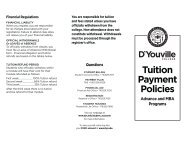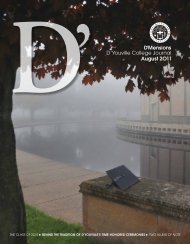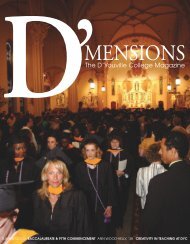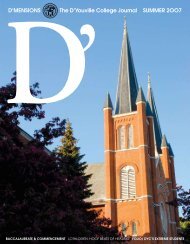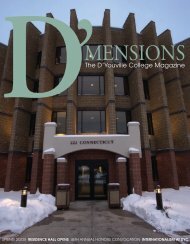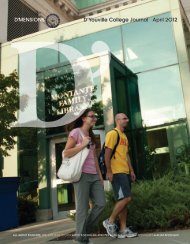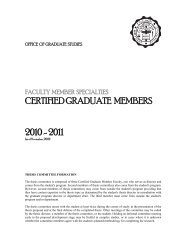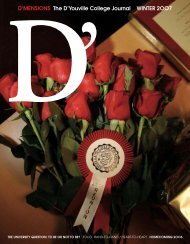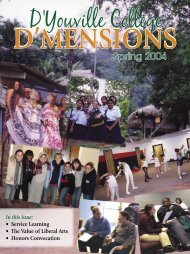d'mensions/the d'youville college Journal summer 2oo6
d'mensions/the d'youville college Journal summer 2oo6
d'mensions/the d'youville college Journal summer 2oo6
- No tags were found...
Create successful ePaper yourself
Turn your PDF publications into a flip-book with our unique Google optimized e-Paper software.
ß 88% of <strong>the</strong> estimated<br />
poor of Tanzania live in<br />
rural areas. 58% of this<br />
population live in abject<br />
poverty.<br />
ß Most girls are pregnant<br />
by <strong>the</strong>ir fourth year of<br />
high school.<br />
ß A private education –<br />
tuition, uniforms, books,<br />
room and board – costs<br />
only 250 (USD) per year.<br />
However, <strong>the</strong> average<br />
median income per rural<br />
household is 890 (USD).<br />
ß Of a national population<br />
of over 34 million,<br />
only 15.9% of primary<br />
school children move<br />
up to public secondary<br />
schools. This is only 6%<br />
of <strong>the</strong> overall population<br />
and is one of <strong>the</strong> lowest<br />
percentages among sub-<br />
Saharan countries.<br />
ß The number of<br />
secondary schools has<br />
grown from 595 in<br />
1995 to 1,745 in 2005;<br />
however, this increase<br />
falls far short of <strong>the</strong><br />
actual need.<br />
ß 80% of rural women<br />
are employed full or<br />
part time in subsistence<br />
agriculture; 30% of<br />
rural micro enterprises<br />
are now owned by<br />
women and this number<br />
is rising.<br />
ß At 7%, <strong>the</strong> national<br />
HIV/AIDS infection<br />
rate has reached crisis<br />
level. Tanzania’s orphan<br />
population is currently<br />
estimated at over 1.1<br />
million.<br />
ß Life expectancy, which<br />
was 65 in 1990, is now<br />
44 and expected to drop<br />
to 37 by 2010.<br />
ß Tanzania is rated 162<br />
out of 175 countries<br />
in <strong>the</strong> 2000 U.N.<br />
Development Program<br />
Human Development<br />
Index. Per capita income<br />
is estimated at 280<br />
(USD), a mere 1.7%<br />
increase over <strong>the</strong> past<br />
five years.<br />
ß At current exchange<br />
rates, <strong>the</strong> Tanzanian<br />
shilling (TZS) is 1250/1<br />
(USD). The $5 million<br />
Mara project rings in at<br />
6,450,197,250 (TZS).<br />
was a good day. We didn’t have enough time, but this was <strong>the</strong><br />
day we opened our eyes about what we are supposed to do.<br />
And from that day Dr. Paulino started to work very closely<br />
with us. We know we are working to build for <strong>the</strong> Tanzanian<br />
girls and women for <strong>the</strong>ir future.”<br />
BACK IN AFRICA<br />
Tanzania, in east Central Africa, is a nation in transition from<br />
single-party socialism to a multi-party democracy. It is a<br />
heterogeneous country of more than 120 ethnic groups with<br />
differing social, economic and cultural environments. In Mara<br />
Region, near Lake Victoria, <strong>the</strong>re are communities of farmers<br />
with varying lifestyles that impede children, and particularly<br />
girls, from getting an education.<br />
While primary education is compulsory, universal and free,<br />
<strong>the</strong> retention of girls through <strong>the</strong> primary grades and beyond is<br />
affected by many factors, including forced marriages (brideprices),<br />
sexual harassment and early pregnancies. With <strong>the</strong><br />
lowest secondary school enrollment in sub-Saharan Africa–<br />
10.3% of <strong>the</strong> age cohort in 2005 – <strong>the</strong>re is an especially urgent<br />
need in Tanzania to expand secondary education in order to<br />
gain parity with neighboring countries’ 30%.<br />
Sr. M. Beata Sungi, Mo<strong>the</strong>r General of <strong>the</strong> Immaculate Heart<br />
Sisters of Africa, has observed, “We are in a society which<br />
for centuries has given girls fewer opportunities of access<br />
to education. As a result, women have had less capability<br />
to participate in <strong>the</strong>ir own spiritual and socio-economic<br />
development, resulting in an overall societal poverty.<br />
However, having a comprehensive school such as <strong>the</strong> new<br />
Mara Education Centre for Girls will not only uplift <strong>the</strong> value<br />
and participation of women in <strong>the</strong>ir own family life, but it also<br />
will contribute to <strong>the</strong> development of Tanzania as a whole.”<br />
In fact, it is now fully recognized by <strong>the</strong> government that <strong>the</strong><br />
emancipation of girls from being reduced to dehumanized<br />
commodities, hinges, in <strong>the</strong> main, on <strong>the</strong> provision of<br />
education. The government has set <strong>the</strong> goal of admitting not<br />
fewer than 4,000 Mara Region girls from pre-K to <strong>college</strong> level<br />
to <strong>the</strong> proposed comprehensive school, which will be built in<br />
three phases over ten years, financed by <strong>the</strong> government of<br />
Tanzania and managed by <strong>the</strong> sisters. The IHSA community<br />
has appointed Sr. Susanna coordinator of <strong>the</strong> project and<br />
negotiator with <strong>the</strong> government at local, regional (state)<br />
and national levels. The government formally approved <strong>the</strong><br />
project in February 2006 and it is presently seeking funding<br />
from international donor organizations such as <strong>the</strong> World<br />
Bank, <strong>the</strong> African Development Bank and USAID.<br />
18<br />
THE MARA EDUCATION CENTRE<br />
FOR GIRLS<br />
The Mara Education Centre for Girls (MAECEG) will<br />
prepare socially responsible leaders for national development.<br />
The girls will participate in scientific activities to develop<br />
competitive, analytical and problem-solving skills, and will<br />
be committed primarily to <strong>the</strong> Mara Region.<br />
As an exemplar of <strong>the</strong> private sector, <strong>the</strong> MAECEG will<br />
provide programs in <strong>the</strong> liberal arts, applied sciences and<br />
technology at different levels. For example, curricula will<br />
include financial literacy, computer literacy and decisionmaking<br />
processes with both individual and collective inputs.<br />
Linkages will be made with <strong>the</strong> international community<br />
of higher education for <strong>the</strong> purpose of participating in joint<br />
economic ventures.<br />
The presence of this new school in <strong>the</strong> Lake Victoria area<br />
will help to promote transformational development of <strong>the</strong><br />
community through fair trade capability, specifically by<br />
empowering women to participate in ethical economic<br />
activities. It is generally recognized that a higher level<br />
of education produces income that decreases women’s<br />
dependence on men and also promotes gender equity.<br />
The school will help to reduce poverty and woman trafficking<br />
by developing a core of semiskilled girls educated through<br />
a market-driven curriculum. This idea is new to Tanzania,<br />
as it is to much of Africa. Critical success factors are those<br />
that will be tangible in <strong>the</strong> minds of <strong>the</strong> students. Learning<br />
assumptions will be related to real life. For example, <strong>the</strong><br />
concept of savings and loans derived from investments cannot<br />
be taught effectively without concrete rewards. Mara does not<br />
have parents who will provide weekly allowances for <strong>the</strong>ir<br />
children; <strong>the</strong>refore, girls will be paid for <strong>the</strong>ir physical and<br />
intellectual contribution to <strong>the</strong> school based on work-study.<br />
FROM THE DRAWING BOARD…<br />
The new Mara school in Kitenga will offer education at all<br />
levels. It is anticipated that <strong>the</strong> pre-primary, primary and<br />
initial secondary levels may start in earnest in 2008. The full<br />
secondary school is conceptualized at capacity by 2014 with<br />
an enrollment of 1,510. Construction will be phased, adding<br />
new components as enrollments build and as cohorts pass<br />
through <strong>the</strong> system in succession.<br />
Plans for a <strong>college</strong> are being developed for <strong>the</strong> subsequent<br />
years. It will feature vocational departments: teacher<br />
education, science, healthcare and social work.



